Technical Publications
These products were developed by Quanterion Solutions for the Reliability Information Analysis Center (RIAC), and are now made available through the RMQSI Knowledge Center.
 Nonelectronic Parts Reliability Data (NPRD-2016)
Nonelectronic Parts Reliability Data (NPRD-2016)
The 2016 edition of the Nonelectronic Part Reliability Data publication (NPRD-2016) presents failure rate data on a wide variety of electrical assemblies and electromechanical/mechanical parts and assemblies. Compared to its predecessor NPRD-2011 publication, NPRD-2016 adds 138,000 new part types and over 370 billion part hours, representing approximately a 400% increase in content. The expanded part types and data in NPRD-2016 cover ground, airborne and naval environments.
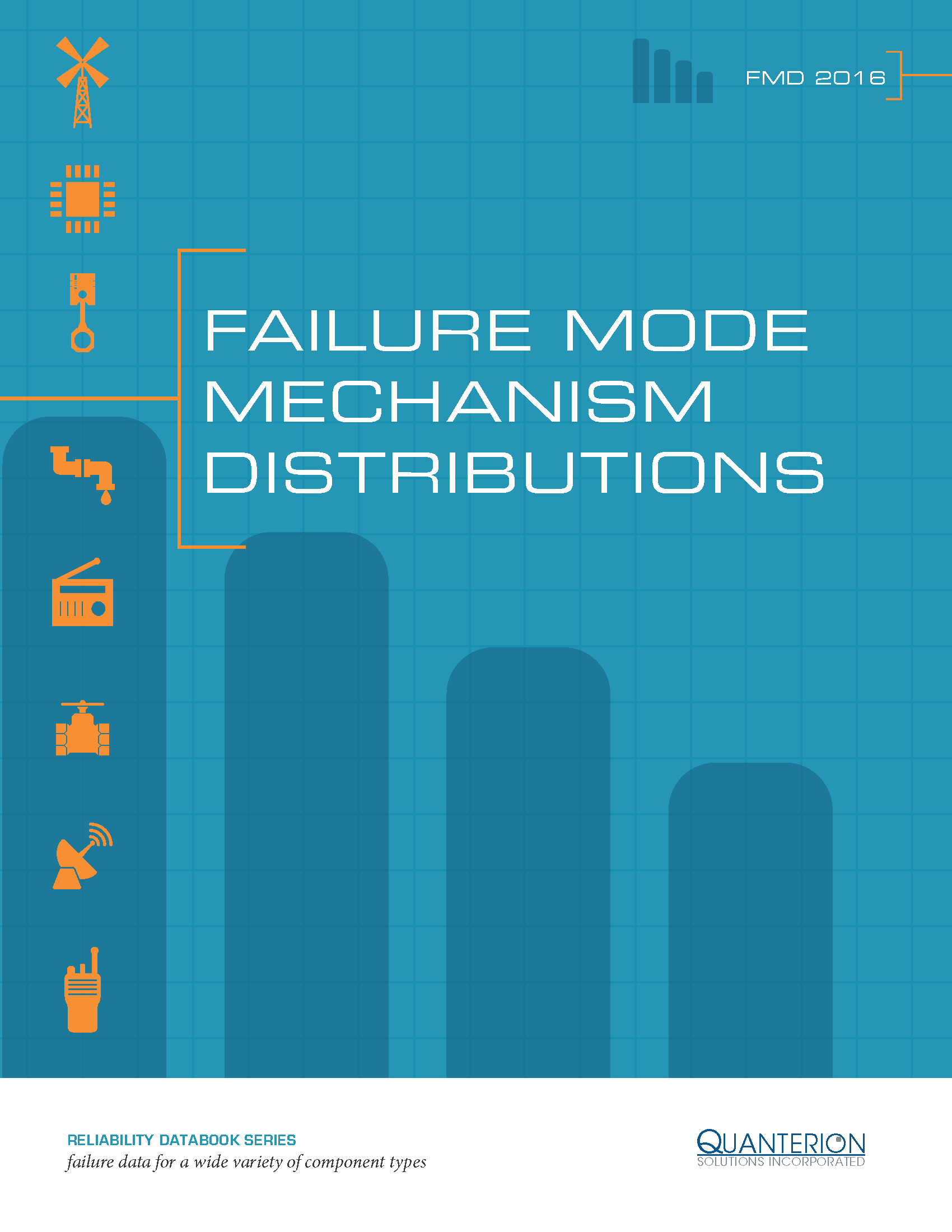 Failure Mode/Mechanism Distributions (FMD-2016)
Failure Mode/Mechanism Distributions (FMD-2016)
The FMD-2016 databook contains field failure mode and mechanism distribution data on a variety of electrical, mechanical, and electromechanical parts and assemblies. This data can be used to assist in the performance of reliability analyses and assessments such as Failure Modes, Effects and Criticality Analysis (FMECA) and Fault Tree Analysis (FTA).
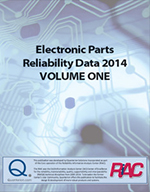 Electronic Parts Reliability Data (EPRD-2014)
Electronic Parts Reliability Data (EPRD-2014)
This document contains reliability data on both commercial and military electronic components for use in reliability analyses. It contains failure rate data on integrated circuits, discrete semiconductors (diodes, transistors, optoelectronic devices), resistors, capacitors, and inductors/transformers, all of which were obtained from the field usage.
 Quanterion Automated Databook (NPRD-2016, FMD-2016, EPRD-2014)
Quanterion Automated Databook (NPRD-2016, FMD-2016, EPRD-2014)
This interactive software tool provides efficient search and retrieval of all information contained in the above described EPRD, NPRD, and FMD hard copy publications. Using its built-in search engine, information may be searched on part number, part types, manufacturer, and National Stock Number (NSN). Additional filters are available to specify application environment and quality levels.
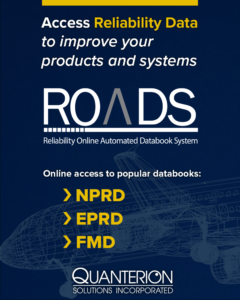 Reliability Online Automated Databook System (ROADS)-All Databooks (NPRD EPRD FMD) Subscription
Reliability Online Automated Databook System (ROADS)-All Databooks (NPRD EPRD FMD) Subscription
The Reliability Online Automated Databook System (ROADS) is a subscription service that provides customized access to all the following above described databooks: NPRD, FMD, and EPRD. The ROADS databooks are updated periodically (as new data warrants) and configuration controlled, so that the data presented is always traceable to a specific version of a hard copy databook.
 HDBK-217Plus™:2015, Notice 1
HDBK-217Plus™:2015, Notice 1
217Plus™:2015, Notice 1 is the latest revision to the popular 217Plus™ Handbook of Reliability Prediction Models based on the original MIL-HDBK-217, Reliability Prediction of Electronic Equipment. Available exclusively through Quanterion, 217Plus™:2015, Notice 1 replaces the original software reliability prediction model with the Neufelder Model for software reliability prediction.
Copyright Neufelder Model © 2021 by Mission Ready Software. Licensed to Quanterion Solutions and used by permission.
 System Reliability Toolkit-V
System Reliability Toolkit-V
This fifth 900-page Toolkit in the popular series developed by Quanterion reflects the updated focus in RMQSI. Several of the same Quanterion staff members have been involved in all five titles in the series. Over 30 new topics have been added, and many others updated from the “System Reliability Toolkit.” Additionally, appendices have been added stressing the practical application of the document’s practices throughout a program’s life.
 Practical Applications of the RIAC System Reliability Toolkit
Practical Applications of the RIAC System Reliability Toolkit
The purpose of this publication is to provide illustrative examples of the more common mathematical calculations and statistical techniques utilized by reliability engineers in the practical performance of their daily activities. It is intended to be used as a companion to the RIAC “System Reliability Toolkit”, as the foundations of all of the techniques illustrated in this publication are discussed therein.
Reliability Toolkit: Commercial Practices Edition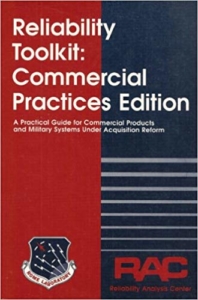
The “Reliability Toolkit: Commercial Practices Edition” helps both the commercial and military sectors deal with developing and manufacturing reliable products in today’s competitive markets. Over 80 topics, representing every aspect of a product’s reliability over its life cycle, have been well received by thousands of Toolkit users to date.
NOTE: The “Reliability Toolkit: Commercial Practices Edition” was published in 1995. It has been updated twice since publication with the latest version, “System Reliability Toolkit-V”
 Supportability Toolkit
Supportability Toolkit
The Supportability Toolkit was developed as a guide for government, government contractors, and commercial industry. It provides common sense, up-to-date information for planning and carrying out those activities needed to develop supportable system and products throughout the life cycle of an item.
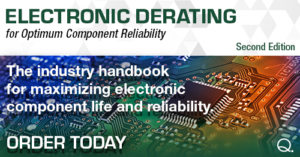
“Electronic Derating for Optimum Component Reliability” is a modern electronic component derating guideline designed to maximize the reliable application of the components in electronic equipment. It includes an introduction to part stress derating and general information relative to part derating theory and definitions and updated electronic component derating guidelines.
The Influence of Reliability, Maintainability, Quality, Supportability and Interoperability on System Affordability
This publication discusses how the effective application of Reliability, Maintainability, Quality, Supportability and Interoperability (RMQSI) tools and processes will ensure that essential warfighting capabilities are delivered that meet system suitability requirements at the most affordable cost.
Free OR2CA Software Tool – purchase this book and receive the Optimized Reliability Requirements and Cost Analysis (OR2CA) tool, a methodology for developing contractual reliability requirements that are fully aligned with stated end-user operational reliability needs and expectations, utilizing the DoD RAM-C Rationale Report Manual to optimize Total Life Cycle Cost (TLCC).
 The Impact of Green Technology on System Reliability
The Impact of Green Technology on System Reliability
The objective of the “Impact of ‘Green’ Technologies on System Reliability” Handbook is to identify the reliability considerations related to key green power generating technologies (solar, wind and geothermal), and to present methodologies and/or models useful in the identification and mitigation of reliability risks.
 Techniques to Evaluate Long-Term Aging of Systems
Techniques to Evaluate Long-Term Aging of Systems
The objective of this publication is to highlight the impact of long-term aging effects on parts, assemblies and equipment by investigating characteristics of aging as they impact specific material classes.
 Mechanical Analysis and Other Specialized Techniques for Enhancing Reliability (MASTER)
Mechanical Analysis and Other Specialized Techniques for Enhancing Reliability (MASTER)
This document is specifically targeted to address the competing approaches to part reliability predictions, including statistical analysis of relevant failure data, physics of failure modeling, empirical failure models and data, and other less common but acceptable methods.
 Achieving System Reliability Growth Through Robust Design and Test
Achieving System Reliability Growth Through Robust Design and Test
This publication offers new definitions of how failures can be characterized, and how those new definitions can be used to develop metrics that will quantify how effective a Design for Reliability (DFR) process is in (1) identifying failure modes and (2) mitigating their root failure causes. Reliability growth can only occur in the presence of both elements.
 Reliability Modeling – The RIAC Guide to Reliability Prediction, Assessment and Estimation
Reliability Modeling – The RIAC Guide to Reliability Prediction, Assessment and Estimation
The purpose of this publication is to provide guidance on modeling techniques that can be used to quantify the reliability of a product or system. There are many ways in which this can be accomplished, depending on the product or system and the type of information that is available, or practical to obtain. It reviews the possible approaches, summarizes their advantages and disadvantages, and provides guidance on selecting a methodology based on the specific goals and constraints of the analyst.
 Expanded Application of FMECA
Expanded Application of FMECA
This “Failure Modes, Effects and Criticality Analysis” publication addresses a number of significant advances from the traditional hardware-centric approach described in MIL-STD-1629A, including Design vs. Process FMEAs (as described in SAE J1739), as well as additional factors to recognize the importance of software and human factors in today’s increasingly complex systems.
Available as a downloadable PDF.

